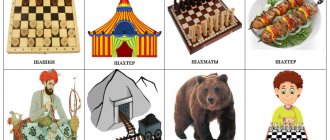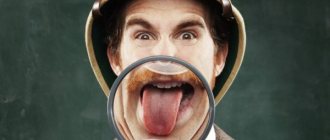It's also the start of the school year in kindergarten. The children are gradually returning from vacation. Many people have learned their letters over the summer and are starting to read a little bit by syllable.
Where do the texts for reading syllables come from? Of course, from the ABC book. The old primers that grandmothers used to learn from are interesting. The second source is the Internet. We also prepare texts for our 5-6 year old students depending on their existing skills, starting with simple and short texts. It is better to read a little, but more often.
In the first texts for reading by syllables, each sentence begins on a new line. This makes it easier for children to understand the text. The first texts to be read syllable by syllable should be printed large.
It is useful to accompany them with coloring books, a familiar activity for preschoolers. The tasks are as follows.
- First you need to read it to your mother, grandmother or someone else.
- Color it.
- Label the items in the picture.
Why is it worth writing words? When a child reads, hearing and vision interact. When writing, I use auditory (pronounce), visual (fix the image of the word) and motor analyzers.
In addition to narrative texts, it is useful to use short simple poems for reading syllable by syllable.
The type of retelling determines how to work on it
It must be borne in mind that there are different types of retellings:
In elementary grades: - retelling and remembering text from pictures. - retelling based on leading questions.
Types of retelling gradually become more complex as the child moves to subsequent grades. And it will be better if parents know in advance what awaits their child in high school and what to prepare him for.
In high school: - retelling a paragraph on the topic being studied. This presentation of the content of the paragraph in your own words, as a rule, is very close to the text, since such texts contain many small but significant details. Subjects: natural history, geography, biology, history, physics, chemistry.
- a brief retelling of the text. The goal is to convey the general idea, the main idea, the plot of the text. Subjects: social studies, history, literature; works of art.
- retelling part of the text. Such tasks are usually given in class. Goal: find that part of the text that answers a question or confirms a thought or statement.
— report at the conference. This is a pre-prepared written speech based on educational and popular science literature. Sometimes it is simply read out, but a story without papers makes a much better impression.
- a monologue expressing one’s own opinion about the actions of the characters or the events described in the text (subjects: social studies, history, literature; excerpts from fiction).
- retelling events on one’s own behalf or from a third party; dramatization of the text. These are types of retellings that involve a creative approach.
As we can see, the texts for retelling can be very different. These include texts from educational literature, scientific texts, popular science, and fiction.
Accordingly, the work on preparing the retelling also varies, depending on the type of retelling.
Secrets of human memory
Sometimes you hear: a child has a bad memory, he cannot remember the text. But few people think about why their memory is bad? And is there anything that can be done to make it better? More often they simply state: he was unlucky with his memory. This means that trying to remember the content of the text is useless. In fact, the point is not that the child has a bad memory. You just need to know some of the features of its functioning.
Today it is a very common belief that there is no need to retain a lot of facts in memory - after all, you can look at the computer at any time and find the information you need. Why clutter your memory with unnecessary information? But this is a deep misconception! People who complain about poor memory most likely feel sorry for their brain and are afraid of overloading it.
Remember what happens to people who move little? Their muscles weaken and atrophy. The same thing happens with our brain. He also needs exercise. Our memory is better the more we make it work. And the more information is contained in our memory, the easier it is to remember new things. The brain can and should be trained.
Difficulties in memorizing information are due to the fact that we can simultaneously hold seven to nine pieces of information in our memory. If we want to remember this information for a longer period, we must repeat it somewhat. Preferably according to a certain scheme.
How do most schoolchildren learn their lessons? It usually looks like this: we do written assignments, we read oral assignments once or twice. Most often, this is where the preparation ends. What is read is safely forgotten by the next lesson.
What can we say about transfer or final exams? By this time, the remnants of knowledge disappear. This, of course, is not about all schoolchildren. But about many. And it's not that they are stupid and stupid. Not at all. Among them there are very smart and smart guys who could achieve significant success if they knew some secrets about the properties of their memory.
When can you start teaching your child to read?
Reading should be taught only when speech therapy problems, if any, have been resolved. Speech disorders can lead to dyslexia (impaired reading process), and in the future to dysgraphia (impaired writing process). The consequence of all this will be low performance at school.
If a child does not pronounce a couple of “uncontrollable” sounds, but in general his speech is clear, this is not so critical. If the baby has porridge in his mouth and cannot pronounce half of the letters, then first of all it is necessary to correct his oral speech with the help of a speech therapist. When learning the alphabet, the baby will learn the letters the way he hears and pronounces them himself, and this will lead to problems in reading and writing.
Age is also important. There are methods that allow you to teach very young children, but you need to understand: is the child really ready to learn, does he understand the explanations, does he like the lessons. Here it is very important to grasp the fine line between the child’s psychological readiness for learning and the ambitions of his parents.
If there are no speech therapy problems or they have already been resolved, if the baby is ready to learn, then it is worth introducing him to the alphabet, and then moving on to reading syllables.
Whoever reads poorly, retells it poorly
There will definitely be difficulties with retelling texts if the child does not read well. Until this obstacle is removed, retelling the text may become an insurmountable obstacle.
It is a proven fact: the faster a person reads, the better he remembers the text. Judge for yourself: if a fifth grader reads syllables, will he be able to prepare a retelling of the text of several pages? After all, he will probably forget even what was at the beginning of the sentence when he gets to his last word.
Therefore, we need to start working on improving our reading technique.
How to teach your child to read quickly and correctly, read here:
Elisa Rosi, Isabelle Flas, Luc Fokrul. "Mom's Key"
This book has very few words and is easy and quick to read. A mother of many children goes on business and leaves three children at home. What could happen to them in her absence? This is the fairy tale “The Wolf and the Seven Little Goats,” only in a new way. Mom forgot her key in the lock. And it was a big mistake. Now she will need diplomatic skills and the gift of persuasion to prove to the children that she is not a wolf and get back into the apartment.
3.
Requirements for a student’s oral speech
There are certain requirements for the speech of a schoolchild (and an adult too). The speaker's speech will make a very good impression if the following requirements are followed:
- continuity of speech , i.e. no unnecessary pauses. A pause can only be determined by the logic of speech and should contribute to its expressiveness. Also unacceptable are all kinds of sounds (uh-uh, ah-ah) that appear when a person selects the right word, especially if this is the so-called “prepared” speech;
- logic, sequence of presentation of events; the ability not to jump from one thought to another, not to be distracted by unnecessary details, to adhere to the general line of the narrative;
— clarity, clarity of presentation of your thoughts , accessibility of presentation;
- developed speech, the use of a variety of linguistic means (a rich vocabulary, skillful and appropriate use of synonyms, the use of various kinds of speech cliches that give the speech completeness and the necessary formality);
- correctness of speech in terms of grammar; correct placement of accents;
— absence of filler words.
- the ability to start your story, continue (develop your thought) and finish.
How to prepare a retelling close to the text
This type of text is difficult due to the abundance of small details. But the child does not need to express his attitude to the content of the text; you just need to present a list of any information or facts. This means that you just need to remember the text and convey its content according to a certain plan.
Where to begin
You need to skim the text with your eyes for general familiarization (the so-called introductory reading). Goal: to get a general idea of the content of the text, to determine the main thought, idea (if it is a literary text), or semantic pieces (if it is an educational text). The level of reading technique is of great importance, since if a child does not read well, introductory reading will not work.
We write down terms and simply unfamiliar words
This stage is necessary because children, as a rule, do not have a very rich vocabulary; In addition, the texts actually contain many unfamiliar words, including terms that you need to know. This work allows you to better understand the content of the text and also helps expand your vocabulary.
Making a short summary
Closer reading. We read the paragraph (or the semantic part of the paragraph, they are usually titled), answer the question “What are we talking about?” We write it down in a notebook. We work through the entire text (or paragraph) in a similar way.
Let's read it again
At this stage, you can use different work options, depending on the child’s type of memory. If verbal-logical memory predominates, it is better to
Preschooler's speech
The most important acquisition in preschool age is considered to be correctly formed speech and sufficient vocabulary.
Preschoolers already know many poems, riddles and fairy tales by heart.
But in order for a child’s personality to develop, it is necessary to diversify the information and complicate the learning material. This will spur the baby’s curiosity and develop in him a desire to learn even more new and unknown things.
It is important to remember that teaching preschoolers should take place in a playful, unobtrusive form. Otherwise, the child will quickly lose interest in what is happening, and in the future, reading will only cause hostility.
Classes must be held regularly, and the material covered must be reinforced every day. To do this, it is not necessary to constantly sit with a primer and do exercises. You can look for familiar letters or words on signs, product packaging, or magazine titles at the newsstand.
It is necessary to become interested in reading from an early age. The good old tradition of reading fairy tales before bed will help perfectly with this. A personal example is also important: it will be useful for a child to see his parents not only in front of a TV or laptop screen, but also with a book in their hands.
Retelling texts with a sequential presentation of facts or events
Many children find it difficult to retell, in which it is necessary to follow a certain sequence of events without violating the logic of the story and without jumping from one thought to another. In such texts, as a rule, each subsequent event is a consequence or continuation of the previous one. Here it is important not to lose the thread, not to break the chain of meaning.
In this case, it is also necessary to divide the text into semantic parts and draw up an outline. But when re-reading and retelling, it is necessary to focus on identifying cause-and-effect relationships (what follows from what).
When retelling texts with a sequential presentation of facts or events, you can use the following vocabulary (where appropriate): first; before; after that; during; periodically; then; meanwhile; Finally…
Exercises for learning to read
Letter memorization exercises
The first step is to teach your child to recognize letters. To do this, you can use pictures with hidden letters. We use such exercises in our pre-school lessons at Skysmart.
Ask your child to identify which letter a word begins with or to name as many words as possible that begin with a particular letter.
Next, we train ourselves to distinguish correctly written letters from incorrect ones. This is also important for learning to write: preschoolers often mirror letters or distort individual elements.
Vowel and consonant exercises
Tasks in which you need to determine what sound a word begins with will help you learn to distinguish vowel sounds from consonants.
Finding the extra letter will also help you remember the difference between vowels and consonants.
Word Forming Exercises
When the child can already read short words, invite him to form a word from letters on his own.
It’s convenient to form words from syllables if you have cubes at hand, but you can try it on paper.
Another good exercise is to fill in the missing letter in a word. Children complete such tasks during lessons at the Skysmart online school.
Even more bright and fun exercises for learning to read are in the school preparation course from Skysmart. Attentive teachers will help your child learn to read, count and express himself through creativity. Classes are held online at a time convenient for the child and parents. Try it for free with an introductory lesson!
How to prepare a short retelling of the text
The goal is to convey the general idea, the main idea, the plot of the text. Subjects: social studies, history, literature; works of art.
Perhaps this is the most difficult type of retelling, since here you need to convey the essence of the story in your own words. That is, you need to catch the most important thing in the text and discard unimportant details.
And this, as a rule, causes difficulties for children.
This kind of retelling should begin immediately after the introductory reading stage. Invite your child to answer the questions: What (and who) were we talking about in general? What event is at the center of the story?
Then you need to find those moments in which events or facts are described that change the course of the narrative (plot). Write down each stage in a briefly formulated form. In other words, we designate the “skeleton” of the text, freeing it from various kinds of reasoning, descriptions, lyrical digressions, etc.
Retelling should be taught from preschool age!
Learning to retell begins from the moment parents read the first book to their child. They will re-read the first books many times. Because the child will ask for it. He will want to hear the contents of the same book again and again, sometimes driving his parents into a frenzy.
But this childhood feature must be used for good. Namely: sometimes replace words and plot moves. The child will be indignant - he will notice any inaccuracy. So let him correct his parents as it should really be. A very simple technique. But very effective and useful.
Sometimes small children imitate reading: they put a book in front of them and retell its contents, while pretending to read. This is also a very useful activity: speech develops, retelling skills appear.
As the child gets older, the content of the books becomes more complex. If his parents read, and not he himself (he doesn’t know how, hasn’t learned), ask him to remind you every time where you stopped reading the last time. What were we talking about? Where should we start reading the book?
It is useful to discuss what you read, but in a way that does not look like an exam. Show genuine interest. Sometimes it is useful to interrupt reading to comment on any action of the main characters (it seems to me that he is wrong...; what a great fellow!...) or ask the child’s opinion: “What do you think, did you do the right thing... why?”
If a child asks to turn on a cartoon, ask which one to turn on. Play along: what kind of cartoon is it, interesting? About what? I haven’t watched it, tell me what it’s about. Let's see together...
If you know the cartoon and have already watched it together, clarify the details: is it about a girl...? About the bunny...? Your child will be happy to remind you what the cartoon is about. Especially if you keep him company and watch it with him.
Play school with your preschooler. Let him be a teacher and tell you something interesting, in his opinion. About dinosaurs. About plants or animals. About cars. Perhaps you read him a book from the Children's Encyclopedia series. Maybe they were told something or read something in kindergarten. Or maybe he will tell you the content of some educational film or children's program.
You just need to keep in mind that the child will only talk if you are really interested in it, and you are on equal terms with him. That is, you are interlocutors. Only in this way, unobtrusively and sincerely, can you instill in your child the first skills of retelling.
Texts for reading by syllables (for preschoolers and first graders)
Texts for reading by syllables (for preschoolers and first-graders)
FRIENDS
Ni-ki-ta and Le-sha are friends. They go to kindergarten together. Le-shi has a sa-mo-kat. And Nik-ki-you has a gun. Not real, but toy. These boys are great guys. O-ni always do-la-tsya ig-rush-ka-mi. And they never quarrel. The two of them play and laugh. It's good to be friends!
IN THE FOREST
It's good in the forest in the summer. The sun is shining, the birds are singing, all the animals are happy. Here is a red squirrel. She is gnawing nuts. Here is a laziness, he plucks grass and drinks water from the stream. And this is a bunny. He's hiding under a bush. Fi-lin is sleeping, and Li-si-tsa is close. Where is Mi-shka Ko-so-la-py? He ate too much and gasped.
Boots
In the morning, Vi-tya and Mi-tya got ready for the kindergarten. You stood up in your red bo-tin-ki, and tied your feet.
- A-it’s out of the way! -decided Vi-cha.
“Let’s do it,” agreed with Mi-cha’s brother.
Sa-dyat-sya with my mother in the bus. And the left Vi-tin bo-ti-nok got together with the right Mi-ti-nym, and oh-ba and sucked off his feet. Suck and swim through the puddle.
Vi-cha and Mi-ta are silently chatting, only their bare legs are squeezing under them. In the kindergarten everything is like that and ah-well: Vi-ti and Mi-tey have two bo-tin-ka on what-you-re-no-gi!.. Good-ro-sho, Pav -lu-shi for-pas-ny-e bo-tin-ki o-ka-za-lis, really, green-e. So all day long Vi-cha and Mi-tay walked around like clowns in the circus: one leg in a red boot, the other one - in the green!
Repeat the letter "SH"
We-sha-ta Ti-sha and Gla-sha - sha-lu-nish-ki. O-ni sha-li-li, sha-ri-li in the corners, shur-sha-li and found cheese, sprats and noodles. We arranged a feast.
Did you bring the cat Mur-ku to the feast?
Assistant.
Weaved a be-loch-ka kor-zi-nu. Weaved from and-in-the-twigs. No one has one in the forest: light-ka-ya, proch-na-ya, kra-si-va-ya.
All summer long the squirrel with the basket hasn’t come... Now the mushrooms are coming, now I’m here, now the grains are with... la.
One day I even found Skvor-chon in the grass. He fell out of the nest, and so he got lost.
He brought the be-loch-ka skvor-chon-ka home and straight into the basket of his do-mik us-tro-i-la.
On New Year's Eve, welcome your friends. How do you see her y-go-schen-e and ah-well: who do you b-loch-ka help?
- Basket! Basket! - Skvor-cho-nok shouted and sang as if spring had come to us.
What did the cat want to tell mom?
—The lazy cat got ready to go roaring. He went to Mama Kosh-ka to tell her about this, but didn’t say:
- Mommy, I love you!
-Ka-ki-e for-a-words! - Ma-ma Kosh-ka was excited. - But it will be better if you tell me how much you love me.
The cat didn't know how to show his love. He decided that sna-cha-la could ma-ma roll wool into a ball, from which he would knit it for him. a row of new and warm things! The balls were getting big, but he wasn't tired at all!
Then the cat started to work with him to sort out the bro-san's ku-bi-ki,
when suddenly we saw a sa-mo-kat in the corner. A beautiful thing came to his head.
Now he deftly walks on one paw and says that circus number ma-me!
The mice - the little ones were glad that the cat didn't go for a walk.
They were always bored without him. And instead, we had a lot of fun playing cat-and-mouse and running around the house! The lazy cat played honestly.
He never looked into the crack under the scarf or bit the mouse's tail.
The lazy cat started puffing. He drank fresh milk and thought about the fact that he didn’t know how you would fulfill Mother Cat’s request. He doesn't know how to show love.
But then he decided that Mama Cat would forgive him for-tit, because her request was difficult, and he only Little cat!
Za-yats and che-re-pa-ha (fairy tale)
Once upon a time, we spored for-yats and che-re-pa-ha, who quickly re-e-ed the forest-well-well about-be-lives. Che-re-pa-ha set off on her way, and the hare-egg lies under a bush, laughing: “Hurry, hurry, wh- re-pa-ha, ve-equal, I’ll talk to you about you.” But while he was wandering around like that, che-re-pa-ha - although she was walking quietly - she appeared at the target. I rushed behind her, but it’s too late. He knew how to run, but he didn’t know that, lying in place, he could get away from the mess.
What are you sisters
There lived sisters in the world: Zi-ma, Ves-na, Le-to and O-sen. Zi-ma by-la se-da-ya, be-la –ya. The weight was young, white-faced, in a green row, with blue eyes. Le-the-same in the green on-rya-de, behind-go-re-lo-e, behind-go-re-lo-e. And O-the shadow of evil-in-lo-sa-ya, in a red sha-li. Zi-ma, Ves-na and Le-to went to visit O-se-ni. On her table there is GRU-shi, and yab-lo-ki, and plum-you, and ar-bu-zy, and dy-ni, and white ka-ra-vai, and pa- whoops honey. Are the sisters going to bless O-sen? O-senior says: No, I must bless you. You, Zi-ma, ground the snow about-de-I-lo-at-the-wing, hid-la from De-da Mo-ro-za, you, Ves-na, po- let it rain-mi-li-va-la, you, summer, clear-but-sun-so-dry-la-lo, so that everything is ripe. Sisters and rads: We all worked hard so that people would get along with God.








